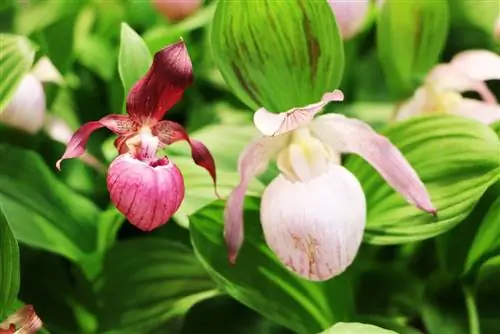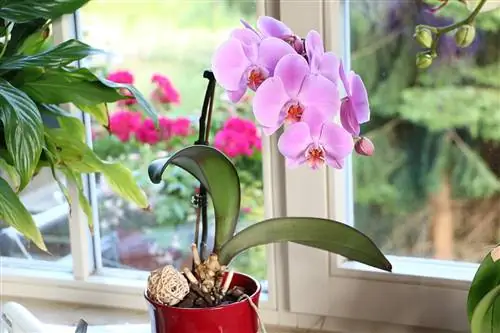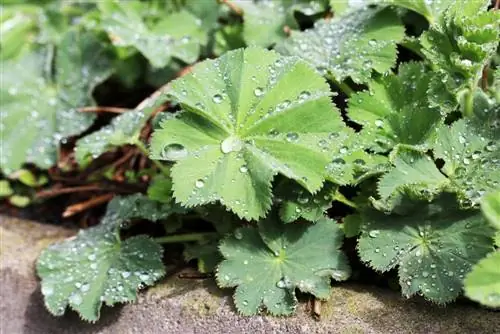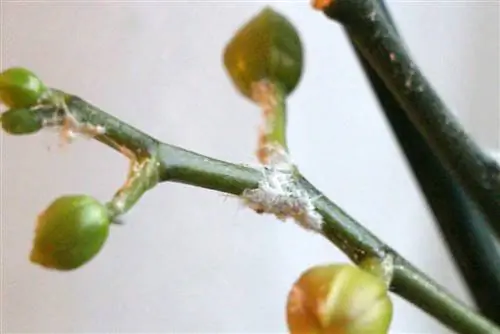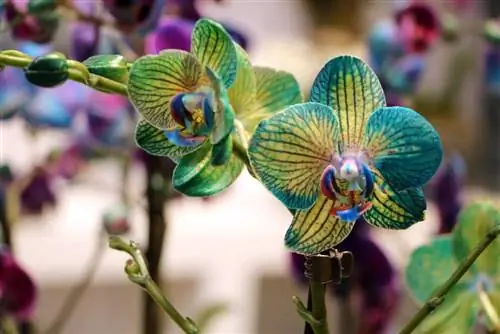- Author admin [email protected].
- Public 2023-12-17 03:39.
- Last modified 2025-01-24 12:45.
The lady's slipper orchids grow naturally in both subtropical regions and temperate areas of the northern hemisphere. In local regions, the winter-hardy lady's slipper can be grown both in the garden and in the living room. With a little skill, the exotic plant will bloom every year, because it is not only completely hardy, but also perennial!
Location
The winter-hardy lady's slipper thrives best in a partially shaded spot. The plant thrives particularly well on morning sunshine and sun in the afternoon or evening. What it doesn't like, however, is the direct midday sun. For example, the open shadow on the north side of a residential building is an ideal place.
However, it can also be planted in a west or south-facing location as long as it is provided with shade and sufficient humidity by neighboring trees. In the interior, the window sill is suitable for an east or west window, but a south window should be avoided. When choosing a location, the following points should also be taken into account:
- cool but not too dry
- Temperatures not permanently above 30 degrees
- Humidity between 50-70 percent
- the higher the humidity, the better
- Provide additional light sources in the interior in winter
- because artificial lighting in the winter months promotes flower formation
Tip:
When choosing a location, it helps to use the ferns as a guide. Because where the ferns thrive, the lady's slippers also grow well.
Neighbors
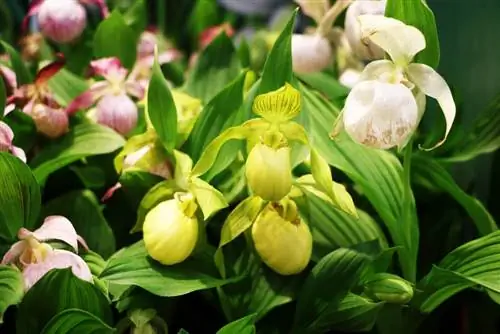
If you want to grow the hardy lady's slipper in your home garden, you should definitely take this plant's future neighbors into account. The decorative plant is considered weak in competition and should therefore not be planted next to fast-growing plants such as trees or large bushes. On the one hand, this is due to their strong root system and their increased nutrient requirements. Added to this is the fact that these plants could simply outgrow the lady's slipper. It is better to grow the lady's slipper orchid next to weak-growing perennials and trees. Good neighbors include:
- Witch hazel (witch hazel)
- Bell Hazel (Corylopsis)
- low ferns
- low perennials
- small hosta varieties
Floor
The plant thrives best in loose and humus-rich soil. The winter-hardy lady's slipper also prefers a moist subsoil, which is why the soil should never dry out completely. However, it is important to ensure that there is no waterlogging, as the plant absolutely cannot tolerate this. If the soil tends to become waterlogged, it is advisable to improve it. To do this, the subsurface is replaced up to 40 centimeters and then a drainage layer made of coarse sand or fine expanded clay is incorporated.
If the soil dries out too quickly, as is the case with light and sandy soils, these should also be improved. The water storage capacity can be increased by mixing the soil with clay granules or perlite. Dense and heavy soils can be loosened by mixing in expanded clay or lavalite (pumice gravel).
- pH value between 5 and 6, 5
- If the value is too high or too low, the susceptibility to diseases increases
- calcareous soil is optimal
- Culture substrate is suitable for culture in the bucket
Tip:
Adding a layer of mulch benefits both the structure and moisture of the soil. Beech leaves or needle litter, which is spread around the planting site, are particularly suitable for this.
Planting
In order to plant the winter-hardy lady's slipper in the home garden, a hole around ten centimeters deep is first dug. Potted orchids can be placed in the planting hole along with the existing substrate. However, for unpotted and bare-rooted plants, it is advisable to carry out the following steps before planting:
- Examine rhizomes for pressure and rotten spots
- these are usually soft and colored brown or black
- remove any damage
- remove these with a sharp cutting tool
- cut into the he althy tissue
- Then cover the interface with charcoal powder
Fertilize
When fertilizing the winter-hardy lady's slipper, it's better to fertilize too little than too much! As a rule, it is sufficient to fertilize the plant during the growing season. Accordingly, the plant is given fertilizer once a month from April to August. A commercially available garden fertilizer is suitable for this, but only in half the concentration! If you are unsure whether the plant is receiving enough nutrients, you can look at the color of the leaves. The leaves should always be a deep green color. However, if the foliage is yellow-green, this is usually a sign of a nutrient deficiency.
- fertilize after flowering with every 3rd or 4th watering
- Fertilize potted plants more sparingly in winter
- Orchids in the garden are not fertilized in winter
Pouring
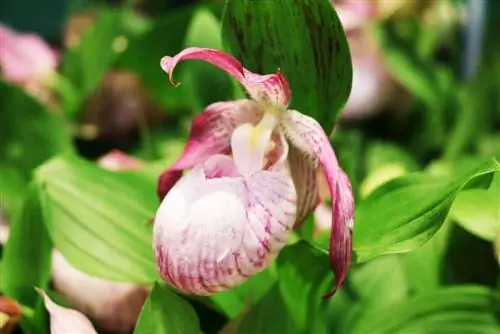
The water requirement of the winter-hardy lady's slipper is comparatively low because the plant stores water in its rhizomes. However, the surface should always be kept moist, especially in the summer months. If drought persists, it is advisable to water the plant carefully. Because both persistent drought and a subsoil that is too wet can lead to the death of the plant.
If the plant is grown in a pot, it is advisable to pour off the excess water in the saucer after a few minutes. When the hardy lady's slipper begins to bloom, a resting phase of growth also occurs. That's why you should water extremely sparingly for about six weeks after flowering.
- preferably water with rainwater
- Alternatively, stale, decalcified tap water is also suitable
Tip:
Do not spray the winter-hardy lady's slipper! This could cause water to collect in the heart, which increases the risk of rot on the flower stem enormously.
Cutting
The actual growth of the plant begins after flowering, because from then on the hardy lady's slipper begins to form new roots. In the so-called rhizomes, the plant stores the energy it needs for new growth in the coming year. In addition, the winter-hardy lady's slipper sucks in the above-ground plant parts as it retreats into the ground to hibernate. From this point on it is advisable to cut back the brown colored foliage. It is also recommended to cut off the dead flower stems. The optimal time for this is when they have wilted all the way down and are completely dry.
Wintering
The winter-hardy lady's slipper is, as its name suggests, completely hardy. Because it can also withstand temperatures down to -20 degrees without damage. Provided the plant is protected by sufficient snow cover, it can tolerate temperatures down to -25 degrees. Otherwise, it is advisable to additionally protect the plant with a layer of pine branches.
Pests
The hardy lady's slipper is often attacked by snails in the home garden. It is therefore advisable to protect the plants from pests in spring. To keep the snails away, it is worth spreading slug pellets. In addition, a snail fence or a vertically placed copper sheet offers protection from unwanted animal visitors. In addition to the snails, the plant is also often attacked by these pests:
- Scale insects
- Mealybugs
- Mites
- Spider mites

